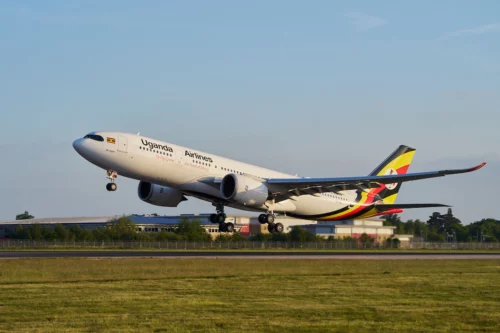We talk to Uganda Airlines CEO Jenifer Bamuturaki about its new service to Gatwick
Links on Head for Points may support the site by paying a commission. See here for all partner links.
On Sunday, London Gatwick airport gained another new route as Uganda Airlines launched non-stop flights to Entebbe.
It marks the first time since October 2015 that there has been a direct service between London and Uganda.
Uganda Airlines is a small fish in the underdeveloped pond of African aviation, but is growing. Launched in 2019, 18 years after the previous Uganda Airlines went under, its goal is:
“To improve Uganda’s Air Transport Connectivity for enhanced competitiveness while optimising return on investment.”
The airline’s mission is much more than transporting people and goods from Point A to Point B. Talking to the airline’s CEO, Jenifer Bamuturaki, it is clear that the airline is a key part of putting Uganda on the map for both tourism and trade.
“We are giving access access to our produce back home. I mean, we have the best pineapples, avocados, vegetables. How do we get them on the shelves of Sainsbury’s?”
“In terms of tourism, we are the home of the gorillas, but we have had a problem with marketing ourselves, because everyone thinks the gorillas are in Rwanda. And it’s not just the gorillas, we also still have the big five.”
Part of the problem has been infrastructure. Up until now, anyone hoping to see the primates in their natural habitat has had to take a long drive from Entebbe to get to the National Parks in Eastern Uganda where they live.
“How do we get the people to see the gorillas, and how do we get them on time to this destination? So we are starting a domestic operation that will make the journey seamless.”
This will require Uganda Airlines to lease smaller aircraft capable of landing on the rugged aerodrome runways in remote parts of the country. This is not something that can be managed by its existing fleet of Bombardier CRJ-900s.
Ultimately, serving both the tourism and trade markets goes hand in hand. Whichever aircraft is chosen – and it’s still very much up in the air – will need to be capable of flying both tourists and cargo from remote parts of the country.
“Our cargo element is very much intertwined with our domestic operation and the type of aircraft we will use. We want the farmer to get his produce on the shelves of Europe.”
At the moment Uganda Airlines operates a tiny fleet of just seven aircraft which consists of two widebody A330-800neos (used for London and Guangzhou), four Bombardier CRJ-900s and one wet-leased A320. But Jenifer plans to grow:
“We are hoping that in the next five years we’ll have doubled our fleet. We are on an expansion drive. We have an approval for four mid-range aircraft, the A320neo and A321neo.”
The airline also has plans for a handful of larger widebodies from Boeing. Two will be dedicated freighters and the other two will be Boeing 787s. But with just a handful of each aircraft variant Uganda Airlines will end up with a very fragmented fleet: why not order some of the larger A330-900neos?
“It’s a decision we’ve had to make because of certain challenges we have with the fleet we’re taking right now.”
“Most of the carriers in Africa are using Boeing and when you think about the bigger picture in terms of maintenance and repairs and how fast you can get spares in and the support around the region, that makes a huge difference.”
It doesn’t help, of course, that Uganda Airlines currently operates the A330-800neo of which there are only seven in service worldwide with a further five on order. It can’t be easy finding spares.
Launching flights to Gatwick marks the culmination of over five years of work, initially with EASA, the European regulator, before transitioning to the UK’s Civil Aviation Authority when Brexit was formalised in 2020.
“And the first thing they said was that we don’t deal with the airline, we deal with the state, and that is the Uganda Civil Aviation Authority. So it’s taken us over five years and a lot of back and forth to get to this point.”
Then there are the UK’s strict security requirements.
“We also had to go through a security assessment. And it was very expensive because it involved purchasing equipment, and to make sure we have a dedicated gate at Entebbe Airport for UK flights.”
Launching an airline requires jumping through a lot of regulatory hoops, and this will continue in 2025 as Uganda Airlines goes through the process of joining the International Air Transport Association and the International Aviation Safety Assessment. Both will make it easier to partner with other airlines on codeshares and joint ventures.
Uganda Airlines’ neighbour and competitor, RwandAir, has been very public about its desire to join the oneworld alliance. Is that important?
“At the moment we are taking it slow. We will do the normal codeshares that enable us to sell tickets, but there are technicalities that come with alliance membership. Obviously you have to lose something to gain something. We’re still growing and I don’t think we are ready to lose certain things.”
Slow-and-steady seems to be the name of the game here. There are no splashy mega-orders for aircraft or promises of life-changing or revolutionary seats.
Instead, Jenifer seems focussed on building an airline that can sustainably contribute to the country’s economy by supporting domestic industries and tourism. Hopefully this results in an airline that survives longer than the quarter century the last Uganda Airlines managed.





 Rhys
Rhys 






Comments (18)